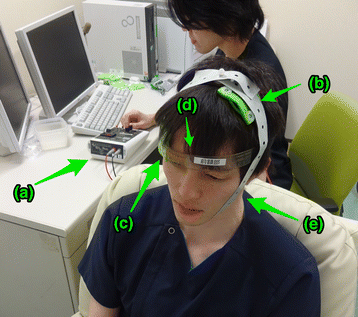Transcranial Direct Current Stimulation (tDCS)
Non-invasive brain stimulation (NIBS) doesn’t directly reduce stuttering but instead enhances speech therapy. Electrical (tDCS) and magnetic (TMS) stimulation are considered to be safe, easy, and inexpensive. In the future speech therapy may include brain stimulation.
Transcranial direct-current stimulation (tDCS) uses electrodes taped to your skull to send a small electric current through your brain. tDCS usually uses two electrodes, the anode and the cathode. The anode stimulates the brain near this electrode. The cathode inhibits neural activity. The electrodes can be placed in various places on your skull. The two most common areas are the inferior frontal cortex and the SMA complex.
Electric (tDCS) Studies
Chesters (2018)[ref]Jennifer Chesters, Riikka Möttönen, Kate E Watkins. Transcranial direct current stimulation over left inferior frontal cortex improves speech fluency in adults who stutter. Brain, Volume 141, Issue 4, April 2018, Pages 1161–1171, https://doi.org/10.1093/brain/awy011[/ref] used transcranial direct current stimulation (tDCS) with thirty adult male stutterers. Each subject received five treatments. Fifteen received active treatment and fifteen received sham treatment (electrodes were taped on the subjects’ skulls but no electricity was switched on). The inferior frontal cortex was targeted. Fluency was enhanced during the sessions with choral speech and metronome-timed speech. Fluency was significantly better in the active group compared to the sham group. Six weeks later this fluency was maintained for reading but not in conversations.
Yada (2019)[ref]Yada, Y., Tomisato, S., and Hashimoto, R. I. (2019). Online cathodal transcranial direct current stimulation to the right homologue of Broca’s area improves speech fluency in people who stutter. Psychiatry Clin. Neurosci. 73, 63–69. doi: 10.1111/pcn.12796[/ref] used tDCS with thirteen adults who stutter (nine men, four women) to stimulate the inferior frontal cortex. The subjects read aloud without speech therapy. The anodes and cathodes were reversed in each subject. This stimulated certain brain areas and inhibited other brain areas. Switching the electrodes then reversed the effects. The electrodes targeted Broca’s and Wernicke’s areas, the brain’s speech and language areas. Sham treatments were also done. The cathodal stimulation resulted in statistically significant improvements in speech fluency. The anode stimulation also showed improved fluency but without statistical significance.
Garnett (2019) [ref]Garnett, E. O., Chow, H. M., Choo, A. L., and Chang, S. E. (2019a). Stuttering severity modulates effects of non-invasive brain stimulation in adults who stutter. Front. Hum. Neurosci. 13:411. doi: 10.3389/fnhum.2019.00411[/ref] used tDCS with fourteen adults who stutter (eleven men, three women) to stimulate the SMA complex. Two sessions were done with each subject, one active session and one sham session. Subjects read aloud in time with a metronome. There were no effects on stuttering conversations. In reading aloud both the active and sham treatments improved fluency slightly (around 3%).
In an ongoing study, Moein (2020)[ref]Moein, N., Mohamadi, R., Rostami, R., Nitsche, M., Zomorrodi, R., Ostadi, A., et al. (2020). Delayed auditory feedback and transcranial direct current stimulation treatment for the enhancement of speech fluency in adults who stutter: protocol for a randomized controlled trial. JMIR Res. Protoc. 9:e16646. doi: 10.2196/16646[/ref] is combining tDCS and delayed auditory feedback (DAF) stuttering treatment. This study has fifty participants, with six sessions each. The experiment is sham controlled. Follow-ups will be done at one and six weeks. Preliminary results are positive.
Magnetic (TMS) Studies
Le Guilloux (2018) [ref]Le Guilloux, J., and Compper, M. (2018). rTMS high frequency on the left pars operculo-orbicularis combined with orthophony improves stuttering. Clin. Med. Rep. 2, 1–2. doi: 10.15761/CMR.1000107[/ref] worked with a 43-year-old “extremely severe” adult male stutterer for whom conversation and reading aloud were impossible. rTMS was applied to his left pars operculo-orbicularis. Camperdown speech therapy was provided. Three sets of ten sessions were done at three month intervals. The man’s speech improved with each sets of sessions. After the last set of sessions “the patient could speak quasi-normally with a discrete stuttering.”
Mejías and Prieto (2019) [ref]Mejías, G., and Prieto, J. (2019). A single case report of a patient with stuttering who improved after open label TMS. Brain Stimul. 12, 785–786. doi: 10.1016/j.brs.2019.01.011[/ref]used rTMS with an adult male stutterer. rTMS was applied to the SMA complex. Fifteen sessions were done over three weeks. The stutterer read aloud in time with a metronome. He had a “fast and strong” improvement in fluency the first week and maintained this fluency for the following two weeks of treatment.
Tezel-Bayraktaroglu (2020) [ref]Tezel-Bayraktaroglu, O., Bayraktaroglu, Z., Demirtas-Tatlidede, A., Demiralp, T., and Oge, A. E. (2020). Neuronavigated rTMS inhibition of right pars triangularis anterior in stuttering: differential effects on reading and speaking. Brain Lang. 210:104862. doi: 10.1016/j.bandl.2020.104862[/ref] used low-frequency repetitive transcranial magnetic stimulation (rTMS) with eight adult male stutterers. Each received a single session (sham controlled). Magnetic fields were applied to the right inferior frontal gyrus to inhibit Broca’s area. Disfluencies increased during conversations and decreased during reading tasks. No speech therapy was provided.
These investigations were done in Turkey, Japan, Iran, France, Spain, the United Kingdom, and the United States. It’s good to see that stuttering research has become international!
Submit your review | |

